March 2025
I love Jean-Michel Basquiat so much.
Eurf, where to start?
I first saw his work on the pages of a book in the Rondebosch Public Library. I was still at school.
Imagine the effect that Basquiat had on someone like me, whose art classes at an apartheid-era high school involved a lot of careful copying in pencil at A4 scale. Basquiat was still alive and everything about his work - everything! - was exciting.
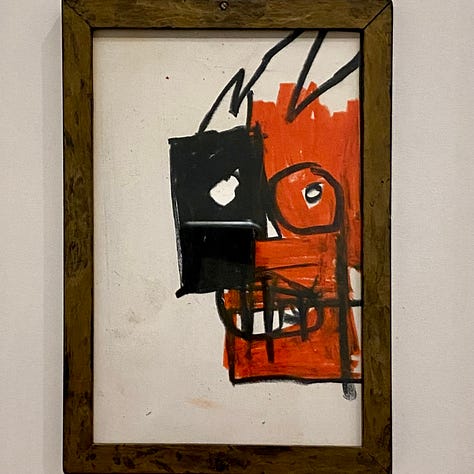

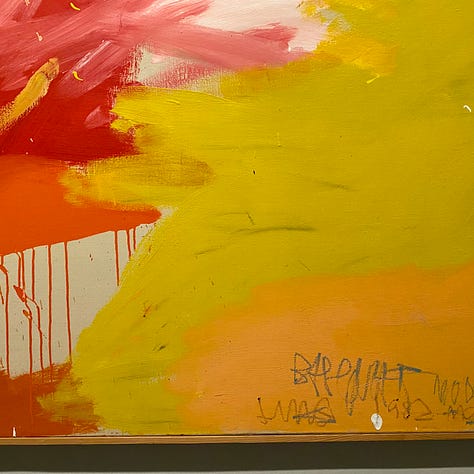

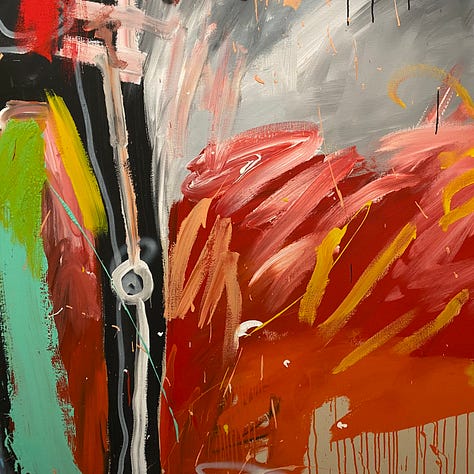
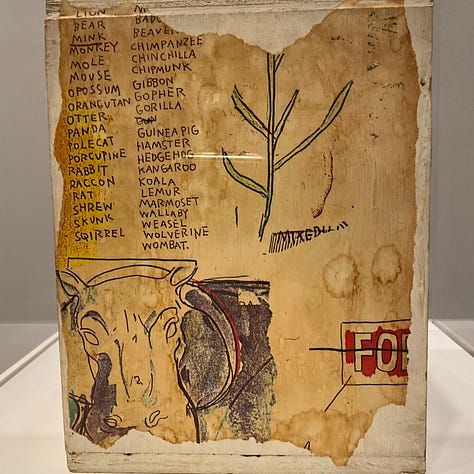
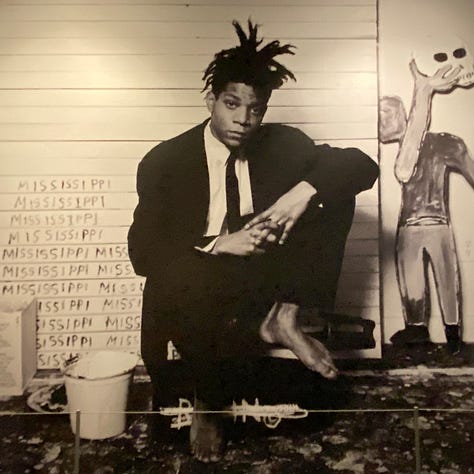
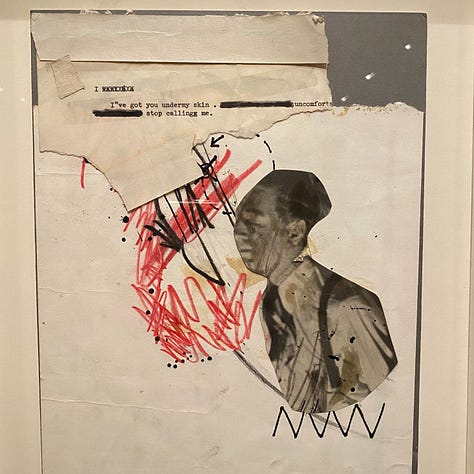
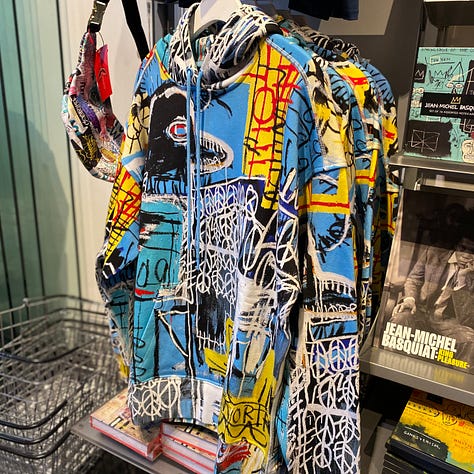
One: Basquiat was not much older than me.
Two: At 17, he and his high school friend Al Diaz started sneaking around the streets of Manhattan at night, spray-painting words and images on buildings, trains and public spaces.
Three: Basquiat used words! In 1980s Cape Town, I loved this. There were slogans and cryptic messages. There was humour.
Four: Basquiat and Diaz signed their work with a “tag”. Their tag was SAMO (pronounced same-oh), which was short for "Same Old Shit”. (When Basquiat started working on his own, he kept the tag.)
Five: (and possibly most importantly) Basquiat’s line and colour jumped off the page. Basquiat drew letters and shapes with strong colour and an exceptionally confident hand. Also, he would scratch, and scribble. He was gestural and rebellious.
He made you want to grab a scrap of paper and a koki. The way he positioned something in a corner, the way he reduced objects to a hard shape … the way he scrubbed some waxy yellow inside the outline a crown, or slashed a brush dripping with brown paint across a surface … He seemed so free but so completely in control.
Six: To a teenager’s mind, Basquiat’s rise to success in the New York art world seemed like a Cinderella story: one minute he was selling sketches on the street to make money for food, the next he was making millions and collaborating with Andy Warhol.
Right now, at the Hirshhorn, there’s a show of one of Basquiat’s big paintings, Boy and Dog in a Johnnypump (1982), along with some of his drawings.
Exhibited alongside Basquiat’s large-scale canvas is UK graffiti artist Banksy’s 2018 painting Banksquiat. Boy and Dog in Stop and Search.
The exhibition is called Basquiat x Banksy. The two works were painted 36 years apart, and on different continents.
Both are privately owned. Basquiat’s canvas sold for over $100 million. Banksy did okay too. His painting was auctioned for close to 10 million Pounds.
Basquiat was just 22 when he painted Boy and Dog in a Johnnypump.
Six years later, in 1988, he died of a drug overdose.
Johnnypump is slang for a fire hydrant. The image is of a boy and his dog on a blazing hot New York street, playing in the cool spray from the open hydrant.
It’s most likely inspired by the neighbourhoods of Brooklyn, where the artist lived.
The Hirshhorn exhibition notes call this work a “Neo-Expressionist painting”. Basquiat uses “vibrant colours and energetic brushworks to represent the fierce heat of a city summer”.
Some critics have drawn attention to Basquiat’s use of particular colours in this work, saying they bring to mind the colours of African kente cloth, the Ethiopian flag and other colour combinations beloved of Pan Africanists.
Another critic cross-references the fire hydrant scene in Spike Lee’s movie Do The Right Thing.
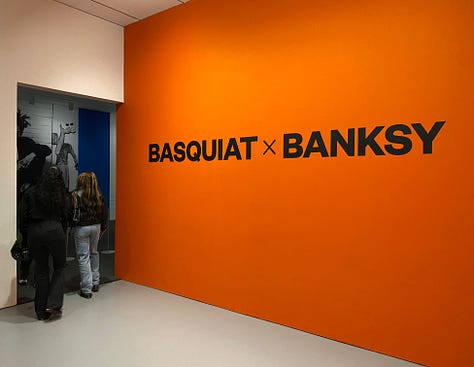


Banksy’s image, originally painted on Golden Lane in central London, copies Basquiat’s boy and dog in Basquiat’s Neo-Expressionist style.
But in Banksy’s painting there is no johnnypump spray. There’s no light or heat. All colour is drained from the image. The dog is smaller. The boy’s hair no longer looks like wet hair flicking over his head. Most significantly, the boy on the street is no longer holding his hands up in glee. He’s keeping his hands up while a pair of London Metropolitan police officers search him.
The police are painted in Banksy’s signature style: spray-painted in black and white using stencils.
The officer searching the boy takes our eye to the young man’s hips. Where Basquiat’s painting of the boy’s bones suggests strength and movement, in Banksy’s work they make him look slender, vulnerable.
The other officer is writing the boy up.
This is the same boy, on the same street. From one painting to the next, joy turns to fear.
Banksy is a graffiti artist whose name and identity remain a secret. He is known for his “humorous and socially provocative street art”.
He’s been working since the early 1990s and is probably the world’s best known street artist.
Under cover of darkness on 17 September, 2017, Banksy crept up to a wall of the Barbican Art Centre in London and painted the first iteration of Banksquiat. Boy and Dog in Stop and Search.
At the time, the Barbican was hosting Basquiat: Boom for Real, a major exhibition of Basquiat’s work.
An extreme interpretation is that the boy is a portrait of Basquiat himself, disempowered by the establishment.
Whether or not portraiture was his intention, Banksy’s appropriation of – or “riffing on” – the central figures in Basquiat’s canvas raises “questions about racial profiling, misuse of power, and the systemic racism Basquiat and people of colour often face”.
The Hirshhorn adds that “for graffiti artists, riffing, even without permission, is often a sign of respect and admiration”.
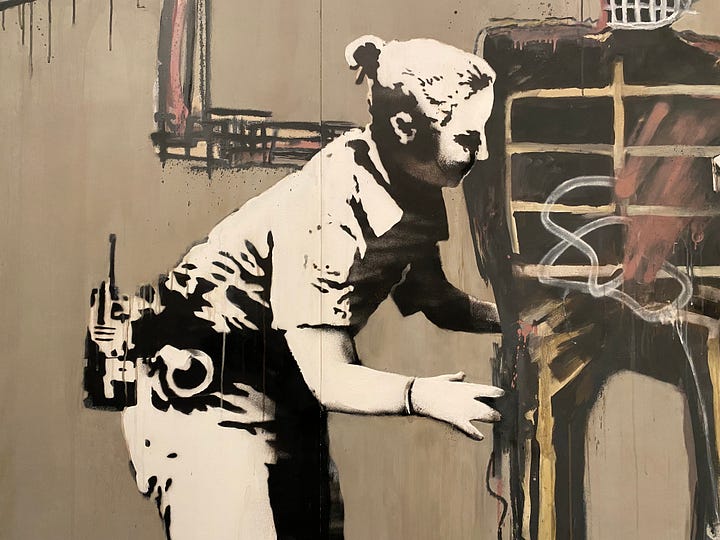

Does Banksy the contemporary artist admire Basquiat, the eighties art star?
The title of Banky’s work is: Banksquiat. Boy and Dog in Stop and Search.
Banksquiat?
Ouch.
Basquiat’s paintings were famously expensive.
He left the street and followed the lure of money and fame into art galleries. He hob-nobbed with the rich and famous. He became a celebrity himself.
Is Banksy judging Basquiat for being swept up in the 1980s world of New York galleries and buyers?
I think Banksy might be reminding us of Basquiat’s one-time presence in that world, but I don’t think he’s judging.
Is Banksy referring to how much money art patrons and sellers were able to bank for themselves through dealing or collecting Basquiat’s work?
Maybe.
Probably.
But Banksy created his own name too.
By calling Basquiat Banksquiat, Banksy also shares his name with the young artist. Banksy makes Basquiat Banksquiat. In a way, he makes them brothers.
One of the loveliest things about showing Basquiat and Banky’s works together is that Bansky fills in the Basquiat story – and not in that tabloid-y way that focuses on Basquiat’s precocious genius, subsequent addiction and tragic death.
With his riff, Banksy inclines his head and shakes Basquiat’s hand – a new generation crediting the old.
The pic above is of a mural in Chelsea, New York, above Empire Diner. The artists are (L_R): Andy Warhol, Frida Kahlo, Keith Haring and Jean-Michel Basquiat.
All photos are my own, except for the one of the Barbican wall. That’s a screenshot from the website Banksy Explained.




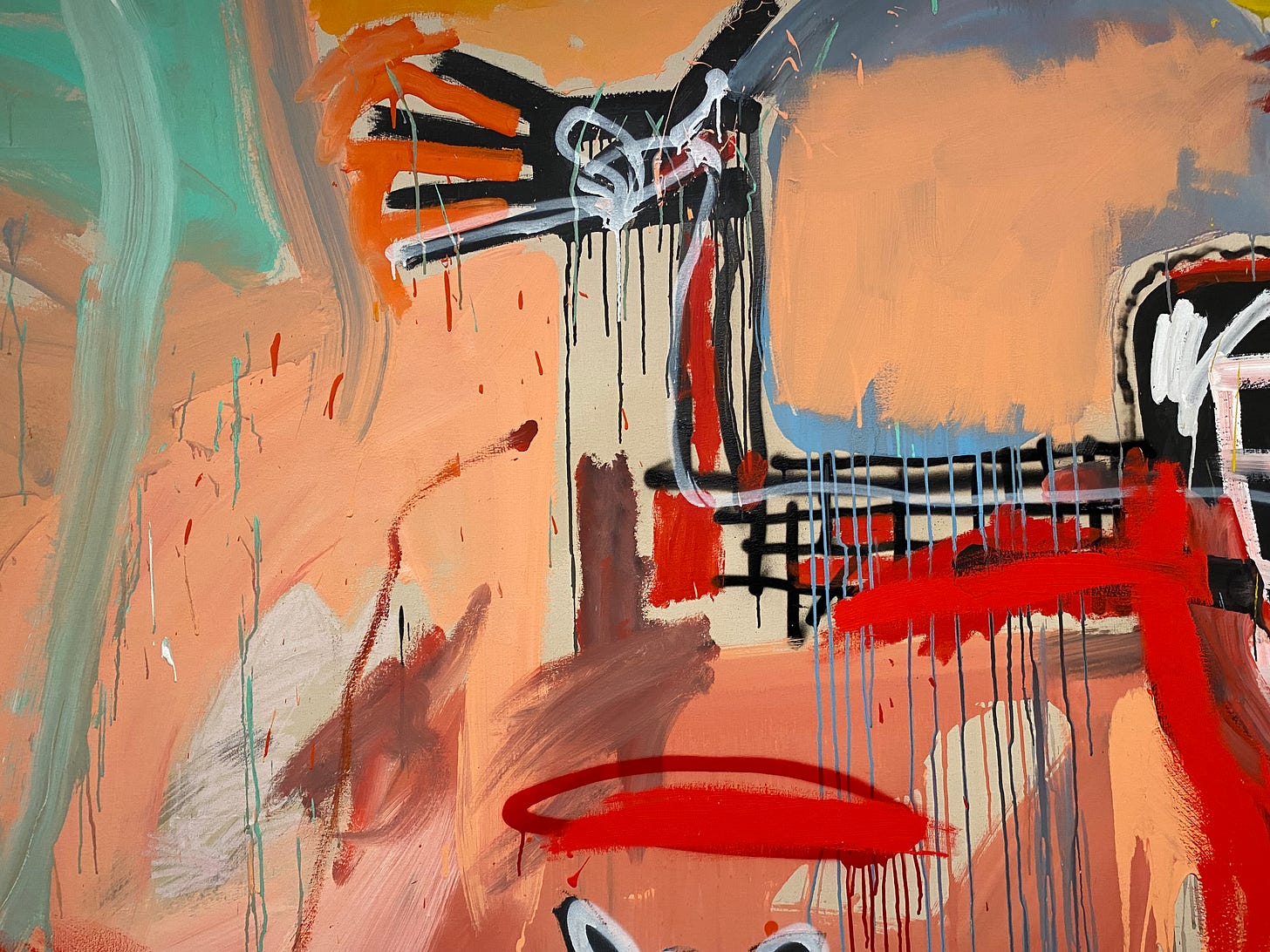
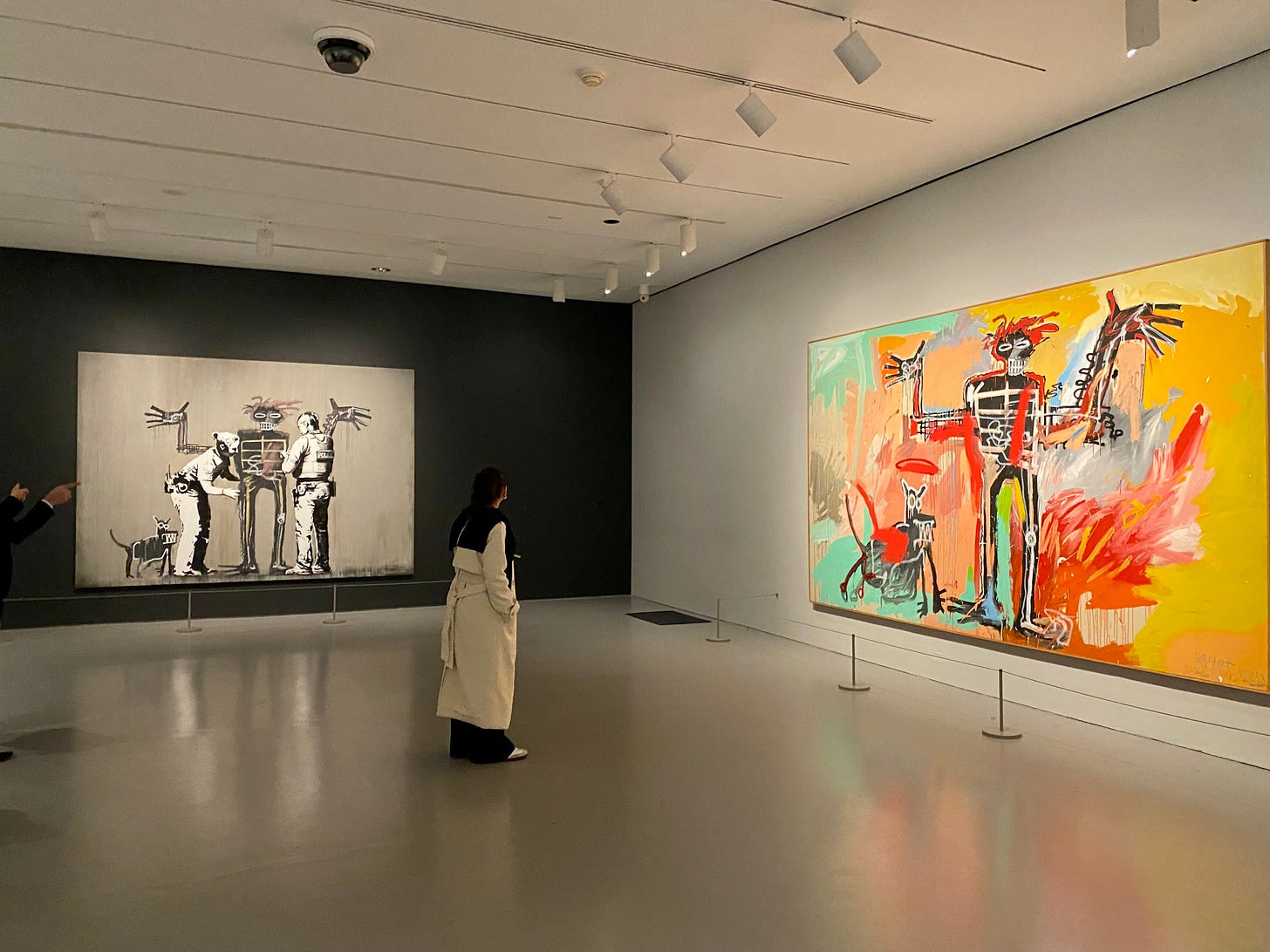


Thanks for this, Daisy. I really enjoyed reading it. How amazing to see the exhibition in real life. Also: I love the pic with the lady on the bicycle, in the red hat.
Thank you for this highlight in my morning Daisy!